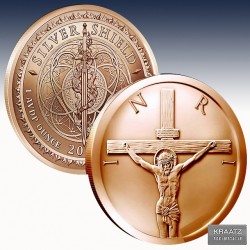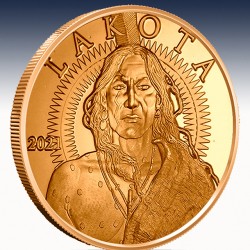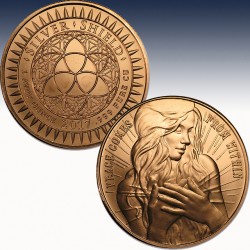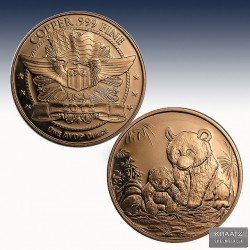- Gold 3.760,50 Eur
- Silber 58,74 Eur
- Platin 1.757,38 Eur
- Palladium 1.502,55 Eur
- (49) 2935 - 3 390 375
- Europaweite Lieferung
- Europaweite Lieferung
- Gold 3.760,50 Eur
- Silber 58,74 Eur
- Platin 1.757,38 Eur
- Palladium 1.502,55 Eur
- SILBER 15,39 EUR
- PLATIN 853,48 EUR
-
Länder / Serien
- Australien
-
Amerika - US Mint
-
Scottsdale Silver & Gold
- Alien Coin Series
- Ägyptische Reliquien Serie
- Cayman Islands - Sea Life
- Eastern Caribbean 8 - Seventh Issue
- Eastern Caribbean 8 - Sixth Issue
- Eastern Caribbean 8 - Fifth Issue
- Eastern Caribbean 8 - Fourth Issue
- Eastern Caribbean 8 - Third Issue
- Eastern Caribbean 8 - Second Issue
- Eastern Caribbean 8 - First Issue
- Congo - Silverback Gorilla
- Grenada Coin Program
- Samoa - Seahorse - Mermaid
- American Eagle - Motive
-
Scottsdale Silver & Gold
- CANADA - Royal Canadian Mint
- Great Britain - Großbritannien
- Somalia Elefant
- Südafrika
- Barbados
- New Zealand - Neuseeland - NIUE - Tokelau
- South Korea - Südkorea
- RUANDA - Serien
- CHINA Motive
- Lunar - Somaliland
- Armenien - Arche Noah
- Cook Islands - Motiv Bounty
- MEXICO
- Kambodscha
- Gibraltar
- Sierra Leone
- Samoa
- Republic of Chad
- Medieval Legends
- Rep. of Gabon
- Kamerun - Cameroon
- Singapur - Mint of MK
- Rep. of Ghana
- Rep. of Congo
- Österreich - Austria
- Saint Helena
- Germania Mint
-
Gold
-
Silber
-
Silbermünzen
- 1/20 - 1/10 - 1/4 Oz Silber
- 1/2 Oz Silber
- 3/4 Oz Silber
- 1 Oz Silbermünzen inkl. diff.best. n. §25a UStG
- 1 Oz Silbermünzen zuzügl.19% MwSt.
- 1,5 - 2 Oz Silber
- 5 Oz Silber
- 10 Oz Silber
- 1000 Gramm/1Kg Silber
- Antique Finish
- Polierte Platte - PROOF
- Golden Enigma / Golden Empire
- Farbig - Coloured
- Silbermünzen "Privy Mark"
- Teilvergoldet - Gilded
-
USA - Silbermedaillen - Silver Rounds
- 1/10 Unzen (oz) Medaillen/Rounds
- 1/4 Unzen (oz) Medaillen/Rounds
- 1/2 Unzen (oz) Medaillen/Rounds
- 1 Unzen (oz) Medaillen/Rounds
- 2oz Ultras High Relief Series - u.a. Privateer, Colonial Tribute
- 2 + 5 Unzen (oz) Medaillen/Rounds
- 1 -25 Unze (oz) Bullets
- Emoji Collection
- Buffalo Silver Round - Collection
- BitCOIN Collection
- Legendary Warriors
- 7 Wonders of the Ancient World Series
- Frank Frazetta Collection
- Mason Mint
- 9Fine Mint Collection
- GSM - Golden State Mint Collection
- United Snakes - Series
-
Intaglio Mint
- Molon Labe Collection
- Patriotic / Militaria Theme
- Cryptozoology Collection
- Colonial Tribute Series
- Japanese Theatre Masks
- Latin Allure Series
- GNOME SERIES
- Greek Mythology
- WILD WEST LEGENDS
- Modern Tribute Collection
- VINTAGE HORROR SERIES
- Religious Theme
- UFO & Alien Series
- T4 SERIES
- Political Satire
- ZOMBIE ZODIACS
- SEVEN DEADLY SINS Series
- CONSPIRACY THEORIES SERIES
- Silver Bullet * Silver Shield u.a. MiniMintage Series
- Chinese ZODIAC Collection
- John Wick Collection
- Open Carry Collection
- Lost World Collection
- Zombucks Series - Currency of the Apocalypse®
-
Münzbarren / Silberbarren / Tafelbarren
-
Silbermünzen
-
KUPFER
-
Kupferbarren/Medaillen
- Anonymous Mint - Copper Rounds
- American Wildlife - SERIES / Tiermotive
- American Indian Series
- Alien Collection
- Dollar - Banknoten
- BitCOIN Collection-Copper Round
- Cannabis - Collection
- Chinese Zodiac - Chinesisches Tierkreiszeichen
- Golden State Mint - Warrior Series - Copper
- Celtic Lore Saga
- Silver Shield - MiniMintage Series
- Merry Christmas - Fröhliche Weihnachten - Motive
- Nordic Creatures
- Kupferbarren
- 1 Unzen (oz) Medaillen/Rounds
- 2 + 5 Unzen (oz) Medaillen/Rounds
- 1 - 2 - 5 - 8 Unzen (oz) Bullets
- 1 oz Copper - Zombucks
- Íntaglio Mint
- Military-Weapon-History Motive
- ZODIAC - Stenzeichen
-
Kupferbarren/Medaillen
- Die Schatzkiste
- ZUBEHÖR
Herzlich Willkommen
1 Unzen (oz) Medaillen/Rounds
292 Artikel gefunden
Sortiert nach:
1 - 12 von 292 Artikel(n)
Aktive Filter











